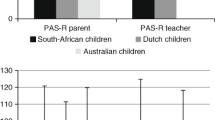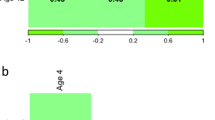Abstract
This study examined the association between insecure attachment, behavioral inhibition, and anxiety in an at risk sample of preschool children. The relationship between maternal anxiety and child anxiety was also assessed. Participants were 104 children aged 3–4 years who were assessed for behavioral inhibition and mother–child attachment (using the Strange Situation procedure). DSM-IV criteria were used to assess childhood anxiety disorders. Insecure attachment and behavioral inhibition were both independently associated with child anxiety, even after controlling for the effect of maternal anxiety. Maternal anxiety was also associated with child anxiety. This study identified both constitutional and environmental factors associated with the expression of anxiety in young children. Furthermore, the highest levels of anxiety were shown by children who were behaviorally inhibited and insecurely attached and whose mothers were also anxious.
Similar content being viewed by others
References
Ainsworth, M. D. S., Blehar, M. C., Waters, E., & Wall, S. (1978). Patterns of attachment: A psychological study of the strange situation. Hillsdale, NJ: Erlbaum.
Ainsworth, M. D. S., & Wittig, B. A. (1969). Attachment and exploratory behaviour of one-year-olds in a strange situation. In B. A. Foss (Ed.), Determinants of infant behaviour (Vol. 4). London: Methuen.
American Psychiatric Association. (1994). Diagnostic and Statistical Manual of Mental Disorders (DSM-IV) (4th ed.). Washington, DC: American Psychiatric Association.
Andrews, G. (1996). Comorbidity of neurotic disorders: The similarities are more important than the differences. In R. M.Rapee (Ed.), Current controversies in the anxiety disorders (pp. 3–20). New York: Guilford.
Barrett, P. M., Dadds, M. R., & Rapee, R. M. (1996). Family treatment of childhood anxiety: A controlled trial. Journal of Consulting and Clinical Psychology, 64, 333–342.
Beidel, D. C., & Turner, S. M. (1997). At risk for anxiety: I. Psychopathology in the offspring of anxious parents. Journal of the American Academy of Child and Adolescent Psychiatry, 36, 918–924.
Belsky, J. (1999). Interactional and contextual determinants of attachment security. In J.Cassidy & P. R.Shaver (Eds.), Handbook of attachment: Theory, research, and clinical applications (pp. 249–264). New York: Guilford.
Belsky, J., & Rovine, M. (1987). Temperament and attachment security in the strange situation: An empirical rapprochement. Child Development, 58, 787–795.
Biederman, J., Rosenbaum, J. F., Hirshfield, D. R., Faraone, S. V., Bolduc, E. A., Gersten, M., et al. (1990). Psychiatric correlates of behavioral inhibition in young children of parents with and without psychiatric disorders. Archives of General Psychiatry, 47, 21–26.
Bowlby, J. (1969/1982). Attachment and loss: Vol. 1. Attachment. New York: Basic Books.
Bowlby, J. (1973). Attachment and loss: Vol. 2. Separation: Anxiety and anger. New York: Basic Books.
Bradley, S. (2000). Affect regulation and the development of psychopathology. New York: Guilford.
Bretherton, I. (1985). Attachment theory: Retrospect and prospect. In I.Bretherton & E.Waters (Eds.), Growing points of attachment theory and research [Monographs of the Society for Research in Child Development, Vol. 50 (Serial No. 209), 3–35].
Carlson, E. A., & Sroufe, L. A. (1995). Contribution of attachment theory to developmental psychopathology. In D.Cicchetti & D. J.Cohen (Eds.), Developmental psychopathology (Vol. 1, pp. 581–617). New York: Wiley.
Cassidy, J. (1994). Emotion regulation: Influences of attachment relationships. In N. Fox (Ed.), The development of emotion regulation: Biological and behavioral considerations [Monographs of the Society for Research in Child Development, Vol. 59 (Serial No. 240), 228–249].
Cassidy, J., & Berlin, L. J. (1994). The insecure/ambivalent pattern of attachment: Theory and research. Child Development, 65, 971–991.
Cassidy, J., & Kobak, R. (1988). Avoidance and its relation to other defensive processes. In J. Belsky & T. Nezworski (Eds.), Clinical implications of attachment (pp. 300–323). Hillsdale, NJ: Erlbaum.
Cassidy, J., & Marvin, R. S. (1992). Attachment organization in preschool children: Procedures and coding manual. Unpublished manuscript, MacArthur Group on Attachment, Seattle, WA.
Dadds, M. R., Rosental Gaffney, L., Kenardy, J., Oei, T. P. S., & Evans, L. (1993). An exploration of the relationship between expression of hostility and the anxiety disorders. Journal of Psychiatric Research, 27, 17–26.
Eley, T. C., & Stevenson, J. (2000). Specific life events and chronic experiences differentially associated with depression and anxiety in young twins. Journal of Abnormal Child Psychology, 28, 383–394.
Fox, N. A., & Calkins, S. D. (1993). Pathways to aggression and social withdrawal: Interactions among temperament, attachment, and regulation. In K. H. Rubin & J. B. Asendorpf, (Eds.), Social withdrawal, inhibition, and shyness in children (pp. 81–100). Hillsdale, NJ: Erlbaum.
Goldberg, S. (1997). Attachment and childhood behavior problems in normal, at -risk, and clinical samples. In L. Atkinson & K. J. Zucker (Eds.), Attachment and psychopathology (pp. 171–195). New York: Guilford.
Goldberg, S., Gotowiec, A., & Simmons, R. (1995). Infant–mother attachment and behavior problems in healthy and chronically ill preschoolers. Development and Psychopathology, 7, 267–282.
Goldberg, S., MacKay-Soroka, S., & Rochester, M. (1994). Affect, attachment, and maternal responsiveness. Infant Behavior and Development, 17, 335–340.
Hirshfeld, D. R., Rosenbaum, J. F., Biederman, J., Bolduc, E. A., Faraone, S. V., Snidman, N., et al. (1992). Stable behavioral inhibition and its association with anxiety disorder. Journal of the American Academy of Child and Adolescent Psychiatry, 31, 103–111.
Kagan, J., Reznick, J. S., & Gibbons, J. (1989). Inhibited and uninhibited types of children. Child Development, 60, 838–845.
Kagan, J., Reznick, J. S., & Snidman, N. (1987). The physiology and psychology of behavioral inhibition in children. Child Development, 58, 1459–1473.
Kagan, J., Snidman, N., & Zentner, M., & Peterson, E. (1999). Infant temperament and anxious symptoms in school age children. Development and Psychopathology, 11, 209–224.
Kennedy, B. L., Schwab, J. J., Morris, R., & Beldia, G. (2001). Assessment of state and trait anxiety in subjects with anxiety and depressive disorder. Psychiatric Quarterly, 72, 263–276.
Main, M., & Cassidy, J. (1988). Categories of response to reunion with parent at age 6: Predictable from infant attachment classifications and stable over a 1-month period. Developmental Psychology, 24, 1–12.
Main, M., & Hesse, E. (1990). Parents’ unresolved traumatic experiences are related to infant disorganized attachment status: Is frightened and/or frightening parental behavior the linking mechanism? In M. T. Greenberg, D. Cicchetti, & E. M. Cummings (Eds.), Attachment in the preschool years: Theory, research, and intervention (pp. 161–182). Chicago: University of Chicago Press.
Main, M., & Solomon, J. (1986). Discovery of an insecure-disorganized/disoriented attachment pattern. In T. B. Brazelton & M. Yogman (Eds.), Affective development in infancy (pp. 95–124). Norwood, NJ: Albex.
Manassis, K. (2001). Child–parent relations: Attachment and anxiety disorders. In W. K. Silverman & P. D. Treffers (Eds.), Anxiety disorders in children and adolescents: Research, assessment and intervention (pp. 255–272). New York: Cambridge University Press.
Manassis, K., & Bradley, S. (1994). The development of childhood anxiety disorder: Toward an integrated model. Journal of Applied Developmental Psychology, 15, 345–366.
Manassis, K., Bradley, S., Goldberg, S., Hood, J., & Swinson, R. P. (1995). Behavioral inhibition, attachment and anxiety in children of mothers with anxiety disorders. Canadian Journal of Psychiatry, 40, 87–92.
Mills, R. S. L., & Rubin, K. H. (1993). Socialization factors in the development of social withdrawal. In K. H. Rubin & J. Asendorpf (Eds.), Social withdrawal, inhibition, and shyness in childhood (pp. 117–148). Hillsdale, NJ: Erlbaum.
Moss, E., Bureau, J., Cyr, C., Mongeau, C., & St-Laurent, D. (2004). Correlates of attachment at age 3: Construct validity of the preschool attachment classification system. Developmental Psychology, 40, 323–334.
Moss, E., Rousseau, D., Parent, S., St-Laurent, D., & Saintonge, J. (1998). Correlates of attachment at school age: Maternal reported stress, mother–child interaction, and behaviour problems. Child Development, 69, 1390–1405.
Nachmias, M., Gunner, M., Mangelsdorf, S., Parritz, R. H., & Buss, K. (1996). Behavioral inhibition and stress reactivity: The moderating role of attachment security. Child Development, 67, 508–522.
Prior, M., Smart, D., Sanson, A., & Oberklaid, F. (2000). Does shy-inhibited temperament in childhood lead to anxiety problems in adolescence? Journal of the American Academy of Child and Adolescent Psychiatry, 39, 461–468.
Rapee, R. M. (1997). Potential role of childrearing practices in the development of anxiety and depression. Clinical Psychology Review, 17, 47–67.
Rapee, R. M. (2001). The development of generalised anxiety. In M. W. Vasey & M. R. Dadds (Eds.), The developmental psychopathology of anxiety (pp. 481–503). New York: Oxford University Press.
Rapee, R. M. (2002). The development and modification of temperamental risk for anxiety disorders: Prevention of lifetime of anxiety? Biological Psychiatry, 52, 947–957.
Reznick, J. S., Kagan, J., Snidman, N., Gersten, M., Baak, K., & Rosenberg, A. (1986). Inhibited and uninhibited children: A follow-up study. Child Development, 57, 660–680.
Rosenbaum, J. F., Biederman, J., Bolduc, E. A., Hirshfeld, D. R., Faraone, S. V., & Kagan, J. (1992). Comorbidity of parental anxiety disorders as risk for childhood-onset anxiety in inhibited children. American Journal of Psychiatry, 149, 475–481.
Rosenbaum, J. F., Biederman, J., Gersten, M., Hirshfeld, D. R., Meminger, S. R., Herman, J. B., et al. (1988). Behavioral inhibition in children of parents with panic disorder and agoraphobia. Archives of General Psychiatry, 45, 463–470.
Rosenbaum, J. F., Biederman, J., Hirshfeld, D. R., Bolduc, E. A., Faraone, S. V., Kobak, R., et al. (1991). Further evidence of an association between behavioral inhibition and anxiety disorders: Results from a family study of children from a non-clinical sample. Journal of Psychiatric Research, 25, 49–65.
Rothbart, M. K., & Bates, J. E. (1998). Temperament. In W. Damon & N. Eisenberg (Eds.), Handbook of child psychology: Vol 3. Social, emotional, and personality development (5th ed., pp. 105–176). New York: Wiley.
Sanson, A., Prior, M., Garino, E., Oberklaid, F., & Sewell, J. (1987). The structure of infant temperament: Factor analysis of the Revised Infant Temperament Questionnaire. Infant Behavior and Development, 10, 97–104.
Sanson, A., Smart, D., Prior, M., Oberklaid, F., & Pedlow, R. (1994). The structure of temperament from age 3 to 7 years: Age, sex, and sociodemograpgic influences. Merrill-Palmer Quarterly, 40(2), 233–252.
Silverman, W. K., & Albano, A. M. (1996). The Anxiety Disorders Interview Schedule for Children for DSM-IV: (Child and Parent versions). San Antonio, TX: Psychological Corporation.
Siqueland, L., Kendall, P. C., & Steinberg, L. (1996). Anxiety in children: Perceived family environments and observed family interaction. Journal of Clinical Child Psychology, 25, 225–237.
Spielberger, C. D., Gorsuch, R. L., Lushene, R. V., Vagg, P. R., & Jacobs, G. A. (1983). Manual for State-Trait Anxiety Inventory (Form Y). Palo Alto, CA: Consulting Psychologists.
Sroufe, L. A., & Waters, E. (1977). Attachment as an organizational construct. Child Development, 48, 1184–1199.
Stevenson-Hinde, J. (2000). Shyness in the context of close relationships. In W. R. Crozier (Ed.), Shyness: Development, consolidation, and change (pp. 88–102). London: Routledge.
Stevenson-Hinde, J., & Marshall, P. J. (1999). Behavioral inhibition, heart period, and respiratory sinus arrhythmia: An attachment perspective. Child Development, 70, 805–816.
Thomas, A., & Chess, S. (1977). Temperament and development. New York: Brunner/Mazel.
Turner, S. M., Beidel, D. C., & Wolff, P. L. (1996). Is behavioral inhibition related to the anxiety disorders? Clinical Psychology Review, 16, 57–172.
Warren, S., Huston, L., Egeland, B., & Sroufe, A. (1997). Child and adolescent anxiety disorders and early attachment. Journal of the American Academy of Child and Adolescent Psychiatry, 36, 637–644.
Author information
Authors and Affiliations
Corresponding author
Rights and permissions
About this article
Cite this article
Shamir-Essakow, G., Ungerer, J.A. & Rapee, R.M. Attachment, Behavioral Inhibition, and Anxiety in Preschool Children. J Abnorm Child Psychol 33, 131–143 (2005). https://doi.org/10.1007/s10802-005-1822-2
Received:
Revised:
Accepted:
Issue Date:
DOI: https://doi.org/10.1007/s10802-005-1822-2




